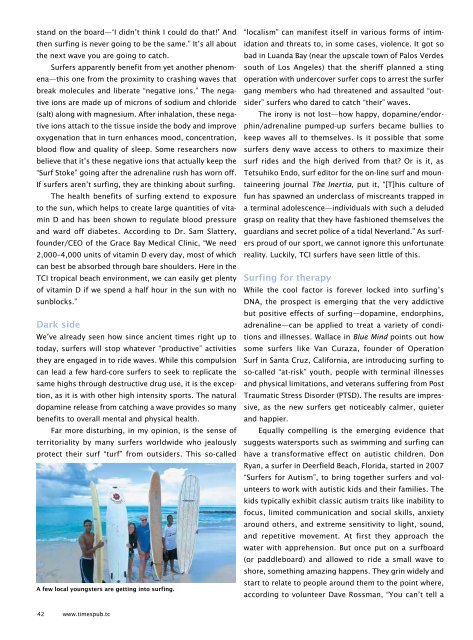Times of the Islands Summer 2017
Presents the "soul of the Turks & Caicos Islands" with in-depth features about local people, culture, history, environment, businesses, resorts, restaurants and activities.
Presents the "soul of the Turks & Caicos Islands" with in-depth features about local people, culture, history, environment, businesses, resorts, restaurants and activities.
Create successful ePaper yourself
Turn your PDF publications into a flip-book with our unique Google optimized e-Paper software.
stand on <strong>the</strong> board—‘I didn’t think I could do that!’ And<br />
<strong>the</strong>n surfing is never going to be <strong>the</strong> same.” It’s all about<br />
<strong>the</strong> next wave you are going to catch.<br />
Surfers apparently benefit from yet ano<strong>the</strong>r phenomena—this<br />
one from <strong>the</strong> proximity to crashing waves that<br />
break molecules and liberate “negative ions.” The negative<br />
ions are made up <strong>of</strong> microns <strong>of</strong> sodium and chloride<br />
(salt) along with magnesium. After inhalation, <strong>the</strong>se negative<br />
ions attach to <strong>the</strong> tissue inside <strong>the</strong> body and improve<br />
oxygenation that in turn enhances mood, concentration,<br />
blood flow and quality <strong>of</strong> sleep. Some researchers now<br />
believe that it’s <strong>the</strong>se negative ions that actually keep <strong>the</strong><br />
“Surf Stoke” going after <strong>the</strong> adrenaline rush has worn <strong>of</strong>f.<br />
If surfers aren’t surfing, <strong>the</strong>y are thinking about surfing.<br />
The health benefits <strong>of</strong> surfing extend to exposure<br />
to <strong>the</strong> sun, which helps to create large quantities <strong>of</strong> vitamin<br />
D and has been shown to regulate blood pressure<br />
and ward <strong>of</strong>f diabetes. According to Dr. Sam Slattery,<br />
founder/CEO <strong>of</strong> <strong>the</strong> Grace Bay Medical Clinic, “We need<br />
2,000–4,000 units <strong>of</strong> vitamin D every day, most <strong>of</strong> which<br />
can best be absorbed through bare shoulders. Here in <strong>the</strong><br />
TCI tropical beach environment, we can easily get plenty<br />
<strong>of</strong> vitamin D if we spend a half hour in <strong>the</strong> sun with no<br />
sunblocks.”<br />
Dark side<br />
We’ve already seen how since ancient times right up to<br />
today, surfers will stop whatever “productive” activities<br />
<strong>the</strong>y are engaged in to ride waves. While this compulsion<br />
can lead a few hard-core surfers to seek to replicate <strong>the</strong><br />
same highs through destructive drug use, it is <strong>the</strong> exception,<br />
as it is with o<strong>the</strong>r high intensity sports. The natural<br />
dopamine release from catching a wave provides so many<br />
benefits to overall mental and physical health.<br />
Far more disturbing, in my opinion, is <strong>the</strong> sense <strong>of</strong><br />
territoriality by many surfers worldwide who jealously<br />
protect <strong>the</strong>ir surf “turf” from outsiders. This so-called<br />
A few local youngsters are getting into surfing.<br />
“localism” can manifest itself in various forms <strong>of</strong> intimidation<br />
and threats to, in some cases, violence. It got so<br />
bad in Luanda Bay (near <strong>the</strong> upscale town <strong>of</strong> Palos Verdes<br />
south <strong>of</strong> Los Angeles) that <strong>the</strong> sheriff planned a sting<br />
operation with undercover surfer cops to arrest <strong>the</strong> surfer<br />
gang members who had threatened and assaulted “outsider”<br />
surfers who dared to catch “<strong>the</strong>ir” waves.<br />
The irony is not lost—how happy, dopamine/endorphin/adrenaline<br />
pumped-up surfers became bullies to<br />
keep waves all to <strong>the</strong>mselves. Is it possible that some<br />
surfers deny wave access to o<strong>the</strong>rs to maximize <strong>the</strong>ir<br />
surf rides and <strong>the</strong> high derived from that? Or is it, as<br />
Tetsuhiko Endo, surf editor for <strong>the</strong> on-line surf and mountaineering<br />
journal The Inertia, put it, “[T]his culture <strong>of</strong><br />
fun has spawned an underclass <strong>of</strong> miscreants trapped in<br />
a terminal adolescence—individuals with such a deluded<br />
grasp on reality that <strong>the</strong>y have fashioned <strong>the</strong>mselves <strong>the</strong><br />
guardians and secret police <strong>of</strong> a tidal Neverland.” As surfers<br />
proud <strong>of</strong> our sport, we cannot ignore this unfortunate<br />
reality. Luckily, TCI surfers have seen little <strong>of</strong> this.<br />
Surfing for <strong>the</strong>rapy<br />
While <strong>the</strong> cool factor is forever locked into surfing’s<br />
DNA, <strong>the</strong> prospect is emerging that <strong>the</strong> very addictive<br />
but positive effects <strong>of</strong> surfing—dopamine, endorphins,<br />
adrenaline—can be applied to treat a variety <strong>of</strong> conditions<br />
and illnesses. Wallace in Blue Mind points out how<br />
some surfers like Van Curaza, founder <strong>of</strong> Operation<br />
Surf in Santa Cruz, California, are introducing surfing to<br />
so-called “at-risk” youth, people with terminal illnesses<br />
and physical limitations, and veterans suffering from Post<br />
Traumatic Stress Disorder (PTSD). The results are impressive,<br />
as <strong>the</strong> new surfers get noticeably calmer, quieter<br />
and happier.<br />
Equally compelling is <strong>the</strong> emerging evidence that<br />
suggests watersports such as swimming and surfing can<br />
have a transformative effect on autistic children. Don<br />
Ryan, a surfer in Deerfield Beach, Florida, started in 2007<br />
“Surfers for Autism”, to bring toge<strong>the</strong>r surfers and volunteers<br />
to work with autistic kids and <strong>the</strong>ir families. The<br />
kids typically exhibit classic autism traits like inability to<br />
focus, limited communication and social skills, anxiety<br />
around o<strong>the</strong>rs, and extreme sensitivity to light, sound,<br />
and repetitive movement. At first <strong>the</strong>y approach <strong>the</strong><br />
water with apprehension. But once put on a surfboard<br />
(or paddleboard) and allowed to ride a small wave to<br />
shore, something amazing happens. They grin widely and<br />
start to relate to people around <strong>the</strong>m to <strong>the</strong> point where,<br />
according to volunteer Dave Rossman, “You can’t tell a<br />
42 www.timespub.tc

















